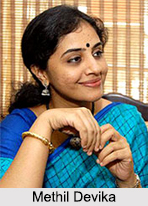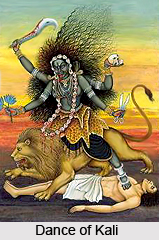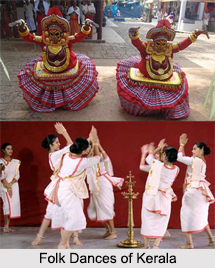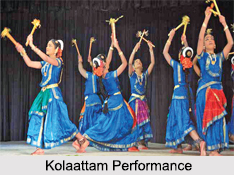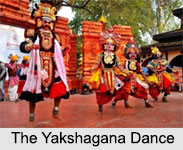 Folk Dances of Karnataka are mainly "Yakshagana" and "Dollu Kunitha". Karnataka is one of the four southern states of India, whose legacy of folk dances dates right from ancient history till date. There are many forms of folk dances of Karnataka, which have recently received due attention of scholars and artists from many parts of India. Some of the prominent folk dances of Karnataka are "Yakshagana" and "Dollu Kunitha" dances.
Folk Dances of Karnataka are mainly "Yakshagana" and "Dollu Kunitha". Karnataka is one of the four southern states of India, whose legacy of folk dances dates right from ancient history till date. There are many forms of folk dances of Karnataka, which have recently received due attention of scholars and artists from many parts of India. Some of the prominent folk dances of Karnataka are "Yakshagana" and "Dollu Kunitha" dances.
Different Folk Dances of Karnataka
Following are the different Folk Dances of Karnataka:
Yakshagana Dance: Yakshagana is a folk theatre form of Karnataka, exemplary of an ancient art relating to many of the traditions and conventions of the Sanskrit theatre or drama, particularly those of the Purvaranga and the existence of a character, vidushaka.
The Yakshagana form developed in Karnataka, Andhra Pradesh and Tamil Nadu. The original form of Yakshagana involves the use of recitative modes of poetry, melodies of music, rhythm and dance techniques, colourful costumes and graceful make up. It distinctly differs in many ways from the norms of the Sanskrit stage, as it does not contain a highly elaborate language of hand and eye-gestures, but it is closely related to developments in literature in the adjoining states of Andhra Pradesh and Tamil Nadu having some affinities to literary forms.
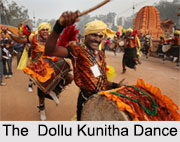 Dollu Kunitha Dance: Dollu Kunitha is one of the ritualistic dances that are popular with the kurubas of `Beereshvara Sampradaya`. Kunitha is accompanied by the beats of the drums and singing of the dancers. The beating drums are decorated by available colours or flowers. Only the men of the shepherd community (Kuruba community) are privileged to perform this dance. The Dollu Kunitha is characterized by vigorous drumbeats, quick dancing movements and synchronized group formations. Another dance form of Karnataka, which is equally famous, is the Puja Kunith where performing dancers carry a wooden type of structure having a deity on their heads. The Dollu dance has a myth related to the divine couple of Shiva and Parvati. The other forms of this dance like - Devare Thatte Kunitha, Yellammana Kunitha, Suggi Kunitha are named according to the deity, symbols or instruments which are balanced on the head or held in the hand of the performer while dancing.
Dollu Kunitha Dance: Dollu Kunitha is one of the ritualistic dances that are popular with the kurubas of `Beereshvara Sampradaya`. Kunitha is accompanied by the beats of the drums and singing of the dancers. The beating drums are decorated by available colours or flowers. Only the men of the shepherd community (Kuruba community) are privileged to perform this dance. The Dollu Kunitha is characterized by vigorous drumbeats, quick dancing movements and synchronized group formations. Another dance form of Karnataka, which is equally famous, is the Puja Kunith where performing dancers carry a wooden type of structure having a deity on their heads. The Dollu dance has a myth related to the divine couple of Shiva and Parvati. The other forms of this dance like - Devare Thatte Kunitha, Yellammana Kunitha, Suggi Kunitha are named according to the deity, symbols or instruments which are balanced on the head or held in the hand of the performer while dancing.
Nagamandala Dance: Nagamandala Dance is a ritual dance presented in south Karnataka to tranquilize the serpent spirit and is an extravagant night-long affair. The serpent of Karnataka`s Nagamandala celebration is generally believed to be the symbol of fruitfulness and a personification of life-force. The celebration of Nagamandala at Karnataka employs music, dance, and ritual chanting in Sanskrit and Kannad and is controlled by the head-priest.
Joodu Haligi Dance: The Joodu Haligi is performed with two percussion instruments. The dance is symbolized by high force and exaggerated expressions by two or three performers. It is mainly performed during the Hindu months of Shravana and Karthika.
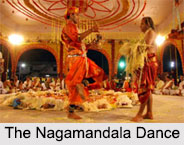 Krishna Parijatha Dance: The Krishna Parijatha dance is popular in Northern Karnataka. From the village squares to open markets, Krishna Parijatha in Karnataka continues to be a popular folk religious theatrical form. Krishna Parijatha of Karnataka is a traditional folk theatre form that is sometimes considered to be a merger of Yakshagana and Byalatta and sometimes as a regional variant of Yakshagana.
Krishna Parijatha Dance: The Krishna Parijatha dance is popular in Northern Karnataka. From the village squares to open markets, Krishna Parijatha in Karnataka continues to be a popular folk religious theatrical form. Krishna Parijatha of Karnataka is a traditional folk theatre form that is sometimes considered to be a merger of Yakshagana and Byalatta and sometimes as a regional variant of Yakshagana.
Bhootha Aradhana Dance: Widely practiced in the coastal regions of Karnataka, Bhootha Aradhana Dance means devil worship. It engrosses a parade in which idols are carried with huge endeavour. The idols are painted in a traditional manner and are meant to symbolize the bhootas or the devils. A curious terrifying feel is imported in the manner of the idols. Drums are beaten and firecrackers are burnt as the big crowd pulls the idols towards a raised platform.
Veeragase Dance: Veeragase Dance is performed in Dussehra festival and is extremely popular during the months of Shravana and Karthika. In reality, it represents the love for the supreme and holds a special place in the folk dances of Karnataka.
Bayalata Dance: This dance is famous among the folk dances of Karnataka in the southern region. It is a spiritual presentation that is frequently fused with drama and dialogues.
The Huttari Dance, Bolak-aat, Ummatt-aat and Komb-aat are the well-liked traditional dance forms from Kodagu Region. In Mysore, the Beesu samsale, kamsale nritya and Somana Kunita are popular. Jaggahalige Kunita, Karadimajal, Krishna Parijatha are popular Folk Dance forms in North Karntaka.
